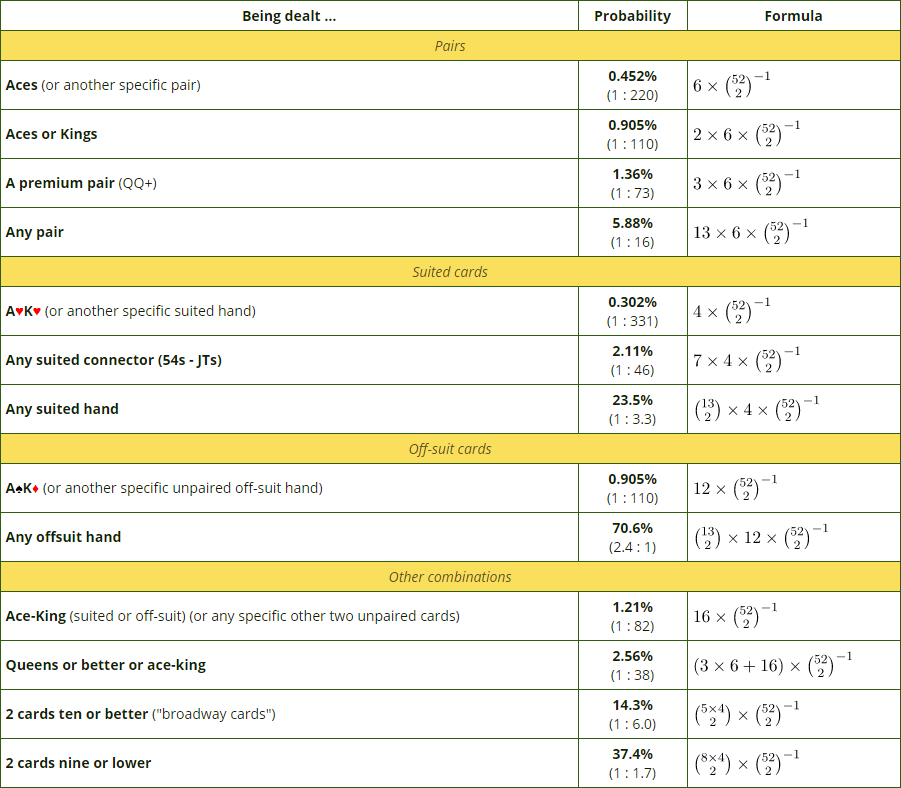Poker Odds Texas Holdem
- Poker Math & Probabilities (Texas Hold'em) The following tables provide various probabilities and odds for many of the common events in a game of Texas hold 'em. Odds% Example Win% 330-to-1 0.30% JJ v 77 80% v 20% 220-to-1 0.45% 55 v AQ 55% v 45% 110-to-1 0.90% 55 v AQs 50% v 50% 82-to-1 1.21% JJ v 75 85% v 15% 82-to-1 1.21% JJ v 75s 80% v 20%.
- Calculating hand odds are your chances of making a hand in Texas Hold'em poker. For example: To calculate your hand odds in a Texas Hold'em game when you hold two hearts and there are two hearts on the flop, your hand odds for making a flush are about 2 to 1.


Both before and after the flop in any limit Holdem game, it is helpful to be able to make a reasonably accurate estimate of the types and numbers of playable hands that you are likely to be competing against.

Texas Hold'em Poker probabilities. When calculating probabilities for a card game such as Texas Hold'em, there are two basic approaches. The first approach is to determine the number of outcomes that satisfy the condition being evaluated and divide this by the total number of possible outcomes. The odds in this Texas Hold'em odds table are unlikely to directly help your overall strategy, but they are pretty interesting nonetheless. The Texas Hold'em odds for each of the different situations have been given in both percentage and ratio odds, so use whichever format you feel comfortable with. Other poker odds charts. In Texas Hold'em, poker odds are THE probability tool you need as a poker player. In fact, you should always be thinking about poker odds - yours and your opponents' - when making decisions. In short, poker odds is the probability of you winning that hand, or the price it offers (pot odds).
Much of your decision making involves the business of 'putting' opposing players 'on their hands' (or in other words, figuring out what cards they are playing). Experienced Holdem players are often very good at this. An understanding of the types of hands that are most likely to be against you helps prevent both underestimating and overestimating your competition.
Here are some stats that are based on the total possible combinations of various Holdem hole cards that are normally playable.
For better viewing on your mobile device (or to download or print the chart), check out holdem hole card frequencies in high resolution universal .pdf format.
The five different types of two card Hold'em hands highlighted here are those that are most commonly played. They are not shown in any particular order and within the groups are powerful hands that are almost always played, down to marginal value hands that can be played under certain betting conditions.
The rest of the hands, shown as All Others, are all the very weak hands that most players hardly ever play.
Pairs - All pairs. AA, KK, QQ, JJ, 1010, 99, 88, 77, 66, 55, 44, 33, 22

Poker Odds Texas Hold'em
Two High Cards Suited - AK(S), AQ(S), AJ(S), A10(S), KQ(S), KJ(S), K10(S), QJ(S), Q10(S), J10(S)
Two High Cards Unsuited - AK, AQ, AJ, A10, KQ, KJ, K10, QJ, Q10, J10
Poker Hand Odds Texas Holdem
Medium and Low Suited Connectors - These include both no-gap and one-gap connectors: J9(S), 109(S), 108(S), 98(S), 97(S), 87(S), 86(S), 76(S), 75(S), 65(S), 64(S), 54(S), 53(S)
Texas Holdem Poker Odds Royal Flush
Ace and Non-High Combinations - A9, A8, A7,A6 Note: 25% of these 64 combinations (16) are suited. 75% of the 64 combinations (48) are unsuited.